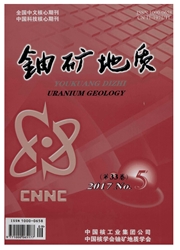

 中文摘要:
中文摘要:
笔者对相山铀矿田邹家山矿床铀矿石中的流体包裹体进行研究,结果表明该矿床的均一温度分布范围较广,为122-360℃。矿床形成温度有两个阶段,分别是高温阶段213-360℃(平均值为263.1℃)和低温阶段122-185℃(平均值为142.7℃),属于中低温热液铀矿床。高温阶段盐度变化范围为(1.74~7.31)wt%(平均值为3.77wt%),低温阶段盐度变化范围为(0.88~2.57)wt%(平均值为1.64Wt%)。矿床成矿溶液高温段的平均密度0.78g/cm3,成矿压力204.57×10^5Pa,成矿深度0.68km;低温段的平均密度0.92g/cm3,成矿压力96.08×10^5Pa,成矿深度0.32km。据此推测,邹家山铀矿床的成矿流体来源主要是岩浆期后热液,同时伴有大气水热液。
 英文摘要:
英文摘要:
This paper is mainly on the fluid inclusions of uranium ores form Zoujianshan deposit in Xiangshang uranium ore-field. Test result of fluid inclusions shew that the homogenization temperature distributed in a wide range from 122℃ to 360 ~C and can be divided into two phases. The high temperature phase was from 213 to 360℃ with the average of 263. 1℃ and low temperature phase was from 122 to 185℃ with the average of 142.7℃, which suggest that the deposit falls into median-low temperature hydrothermal deposits. In high temperature phase, the salinity of inclusion was (1.74-7.31) wt% with the average value of 3.77wt%, and in low temperature phase the salinity ranged from 0.88wt% to 2.57wt% with the average of 1.64wt%. In high temperature phase, the mineralization solution was with the average density of 0. 78g/cm3 and the pressure of 204. 57 × 10^5 Pa which refer to the depth of 0.68km. In low temperature phase the mineralization solution was with the average density of 0.92g/cm3 and pres- sure of 96.08×10^5Pa which refer to the depth 0. 32kin. By summarizing the above information, we can inferred that the ore forming fluid is the main from post-magmatic hydrothermal fluid which was accom- panied by atmospheric water.
 同期刊论文项目
同期刊论文项目
 同项目期刊论文
同项目期刊论文
 期刊信息
期刊信息
